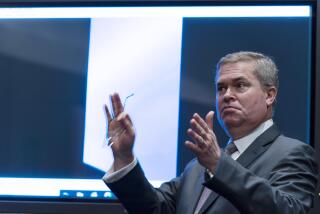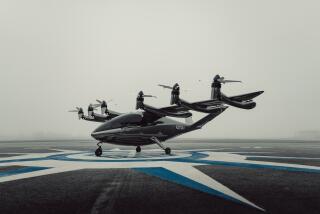Ultralight Industry Has High Hopes for FAA Regulation
- Share via
An ultralight is a small aircraft. It looks like an airplane, sounds like an airplane and even flies like one.
The similarities end there, however. You don’t need a pilot’s license to fly an ultralight, you don’t have to register the aircraft and, if you crash it, as long as you’ve hurt only yourself, you don’t have to report it or answer to authorities.
But that may soon change; the ultralight industry has come under the scrutiny of the Federal Aviation Administration, which is considering more stringent regulations, similar to those governing general aviation.
What’s more, in a period of governmental deregulation, the ultralight industry is generally welcoming the FAA with open arms.
Andrew Gold, owner of the San Diego Ultralight Park on the Barona Indian reservation in Ramona, said the more regulation by the FAA, the better. He said regulation would be a “legitimizer” for the sport and “would help the industry.”
Gold trains students in an experimental two-seat aircraft similar to an ultralight. Ordinarily, FAA regulations prohibit experimental aircraft from carrying passengers. But the ultralight industry, via the Aircraft Owners and Pilots Assn., has an exemption from the FAA to employ the two-seater for training purposes.
Gold said the main benefits the industry could reap from regulation would be easier access to insurance and improved public perception of the industry. He said FAA regulation might scare some potential customers away but that “for every one it would scare, it would bring in 10 more.”
Gold left the shoe sales business two years ago to buy the ultralight park because “this is where aviation is going to go . . . in light aircraft for leisure.”
The Aircraft Owners and Pilots Assn.’s Air Safety Foundation, in response to the 1982 FAA request that the industry regulate itself, instituted an ultralight division in January, 1983, to license ultralight pilots and aircraft on a purely voluntary basis. In December the program was transferred to the newly established United States Ultralight Foundation, which has headquarters in Frederick, Md.
John Ballantyne, director of the new organization, said the program has 3,768 ultralight pilots certified, 1,330 ultralight pilot examiners and 1,732 ultralight aircraft registered.
Gold’s ultralight park and San Diego County’s only other ultralight facility, run by Blue Yonder in the Otay Lakes area, both participate in the new organization.
Bob Mercer, an ultralight dealer for Blue Yonder, said of regulation, “I think it’s going to help the sport in every way.”
Patricia Weil, spokeswoman for the Aircraft Owners and Pilots Assn., said the voluntary licensing program has received a 15% participation among ultralight enthusiasts and added that one of the appeals of the voluntary program is that it enables ultralight enthusiasts to obtain insurance more easily. She said further regulation is welcome.
“I think you won’t find people really adverse to regulation,” Weil said. “People are already registering their vehicles voluntarily. The general feeling in the ultralight community is that further regulation will not hurt.”
Flying ultralights is similar to “the difference between riding a motorcycle and (driving) a Cadillac,” said Frank Price, 34, a recent ultralight enthusiast. “It’s exciting--there’s nothing like it.”
Price, a boiler mechanic at Camp Pendleton, said he switched from flying a Cessna to flying an ultralight because “I wanted to fly, but the cost of general aviation was too high.”
He said he read an advertisement on ultralights in a magazine and went to the San Diego Ultralight Park to “check it out.”
Upon arrival at the park, his wife, Sharon, told him, “You’ve got to be kidding. You’re not flying this thing.”
She said she was initially opposed to her husband’s flying an ultralight “just by the look of the things.” She said, however, that after she had a chance to read up on ultralights that she changed her mind. She will begin her ultralight flight instruction this summer.
The Prices recently bought their own craft, which Frank said will take him 45 hours to build in his garage. Ultralights sell for anywhere from $3,500 for a used craft to about $10,000 for the top-of-the-line model.
Ultralights evolved from experiments by a Wisconsin man, John Moody, in 1976 on hang gliders. Moody rigged a 10-horsepower engine taken from a chain saw to a propeller mounted on a hang glider so he could keep the craft in the air longer. From his experiments came the first ultralight in 1978.
The ultralight industry took off in the early 1980s. It attracted fliers who either could not afford to fly conventional aircraft or preferred to fly lower, slower and in an open cockpit that provides a greater view than in an ordinary aircraft. They require less than 200 feet to take off and land. Ultralights have been adapted to perform crop-dusting and have even found their spot in the military. The government has converted ultralights for use in reconnaissance and even attack missions, Gold said.
Along with the burgeoning ultralight industry came only basic FAA guidelines. FAA Regulation 103 prohibits the ultralight pilot from flying at night, over congested areas or within an airport control area, which is generally three miles around an airport.
The ultralight itself may carry only one person, have a maximum speed of 55 knots, be used only for recreation or sport, weigh a maximum of 254 pounds unloaded, have only one engine and hold a maximum of five gallons of fuel.
According to Fred Farrar, spokesman for the federal Department of Transportation, his agency is considering more stringent regulation of the ultralight industry. Farrar said such regulations could include registration of the aircraft, licensing of pilots, performance requirements and airworthiness certificates. Those rules are similar to those governing general aviation, although Farrar said he doubted they would be as strict.
“Three years ago, we instituted the minimal standards we essentially have today,” Farrar said, referring to Regulation 103. He added that, at the time, the Department of Transportation intended to let the industry regulate itself, hoping to avoid large-scale FAA involvement.
The push to further regulate is in response to a series of FAA public forums of ultralight pilots, manufacturers and dealers last fall in Washington, Chicago, Dallas and Los Angeles. Farrar said that those attending the meetings were asked, “Has there been an adequate amount of self-regulation?”
Farrar said the responses were generally negative, prompting the department to consider further regulation.
According to Carol Floyd, spokeswoman for the National Transportation Safety Board’s accident department, the board voluntarily began to investigate ultralight accidents in 1983 in response to a fatal accident a year earlier. Board statistics indicate there were 106 accidents involving ultralights in 1983, with 57 fatalities. In 1984, there were 71 accidents, with 36 fatalities.
With those statistics in hand, the safety board conducted an “ultralight safety report” and recommended that the FAA establish minimum standards of airworthiness for the aircraft, establish a certification program for pilots, require registration of the aircraft and extend the ultralight community the privileges and restrictions in the general operating rules for general aviation.
More to Read
Inside the business of entertainment
The Wide Shot brings you news, analysis and insights on everything from streaming wars to production — and what it all means for the future.
You may occasionally receive promotional content from the Los Angeles Times.










